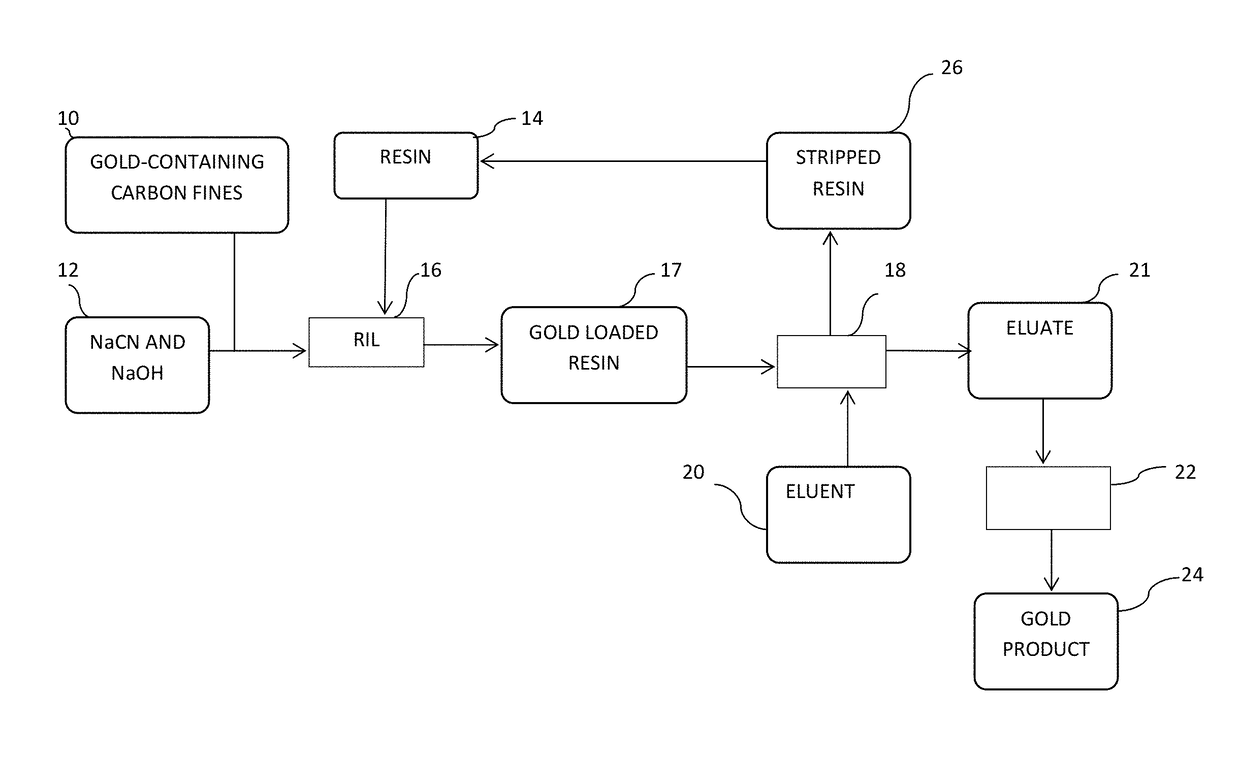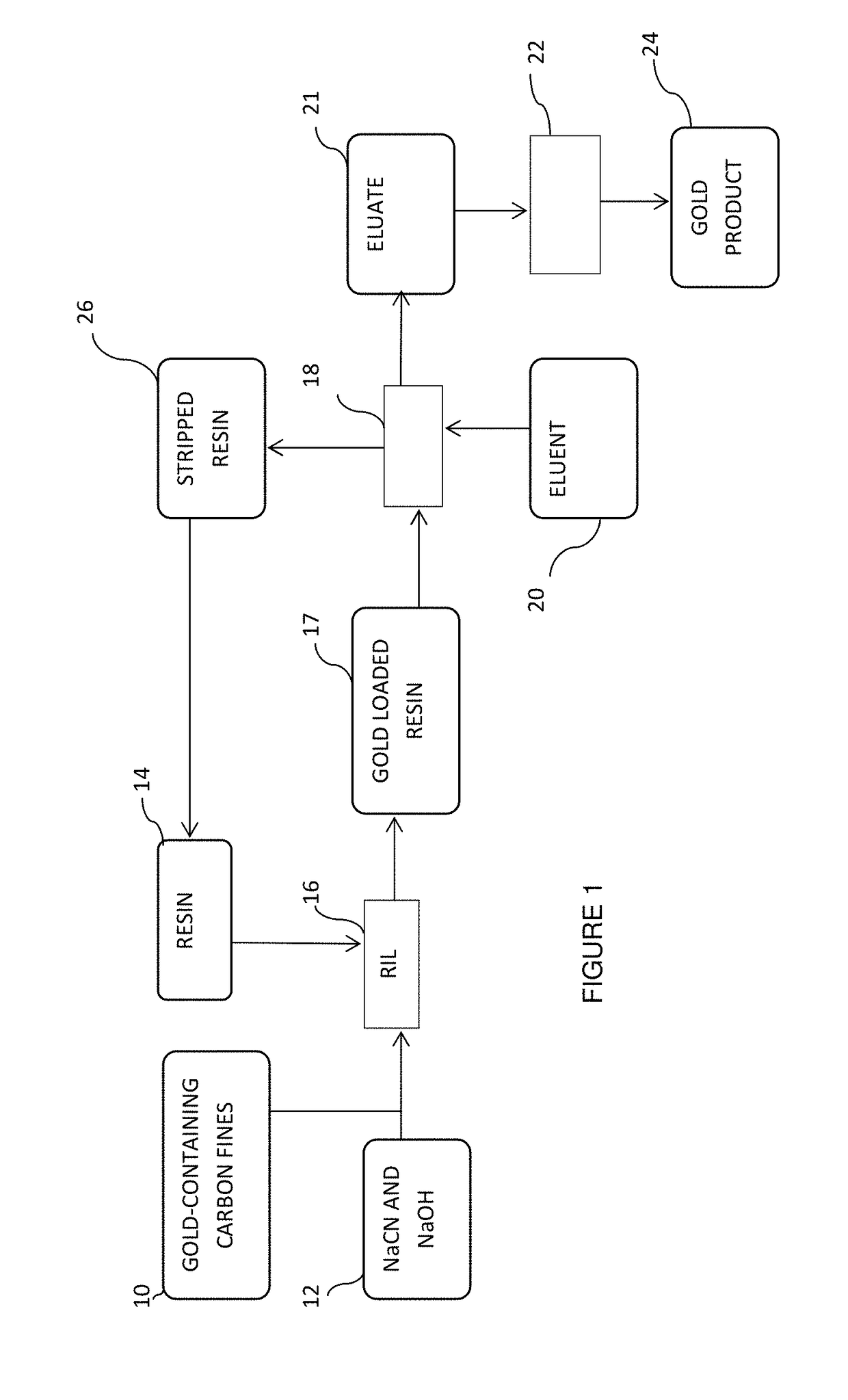Gold recovery from carbon
a gold recovery and carbon technology, applied in the field of gold recovery from carbon fines, can solve the problems of gold loss, high cost of combustion process, process and then loss,
- Summary
- Abstract
- Description
- Claims
- Application Information
AI Technical Summary
Benefits of technology
Problems solved by technology
Method used
Image
Examples
example 1
very from Synthetically Loaded Carbon Fines
[0023]Activated carbon (300 g) was contacted with 3 L of a gold (Au) cyanide (CN) solution containing 200 mg / L Au as Au(CN)2, at pH 11. Pre-loading of the carbon was done in a rolling bottle for 24 hours. After loading the carbon was filtered from the solution, dried and pulverized. A feed solution and a barren solution were each submitted for gold analysis by atomic absorption spectroscopy. The loading of the carbon was calculated to be 1759 mg / kg (or g / t).
[0024]Five equilibrium isotherms were generated at the conditions specified in Table 1.
[0025]
TABLE 1Conditions used for generation of equilibrium isothermsCN−,NaOH,Temperature,Testmg / Lmg / L° C.12001Ambient25001Ambient310001Ambient41000100Ambient5100010060
[0026]Carbon loaded with gold was mixed with an alkaline cyanide solution at a solid-to-liquid ratio of 1:4 (20% m / m solids). The “pulp” obtained was contacted with different amounts of a strong base resin with TBA groups (Dow XZ 91419) i...
example 2
very from Actual Carbon Fines
[0039]A sample of carbon waste, representing typical carbon waste from a South African gold mine, was analysed. The sample contained 215 g / t Au and a significant amount of impurities, especially Si (1.26%), Al (1.8%), Fe (1.4%) and Ca (6.81%). The composition of the sample is specified in Table 4.
[0040]
TABLE 4Chemical composition of a typical sample of carbon waste from a SouthAfrican mine (g / t)AuMgAlSiCaTiFeNiCuZn21552518450126006810010501365011009251450
[0041]The sample was milled down to 100% passing 125 μm, and was mixed with cyanide alkaline solution containing 1 g / L cyanide as NaCN and 0.1 g / L NaOH at a solid to liquid ratio of 1:4 (20% w / w solids). The “pulp” obtained was contacted with different amounts of a strong base gold selective resin, Minix, at 60° C. After 24 hours of contact in rolling bottles, the resin beads were separated from the carbon pulp, and the carbon was filtered. The carbon fines and the Minix resin beads were washed, dried an...
PUM
| Property | Measurement | Unit |
|---|---|---|
| concentration | aaaaa | aaaaa |
| temperature | aaaaa | aaaaa |
| concentration | aaaaa | aaaaa |
Abstract
Description
Claims
Application Information
 Login to View More
Login to View More - R&D
- Intellectual Property
- Life Sciences
- Materials
- Tech Scout
- Unparalleled Data Quality
- Higher Quality Content
- 60% Fewer Hallucinations
Browse by: Latest US Patents, China's latest patents, Technical Efficacy Thesaurus, Application Domain, Technology Topic, Popular Technical Reports.
© 2025 PatSnap. All rights reserved.Legal|Privacy policy|Modern Slavery Act Transparency Statement|Sitemap|About US| Contact US: help@patsnap.com



